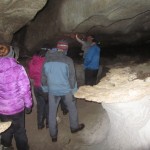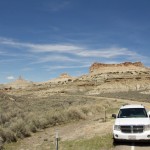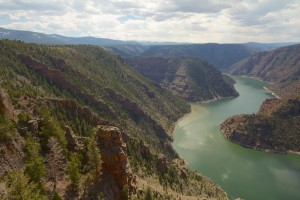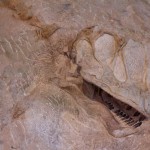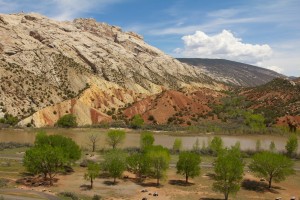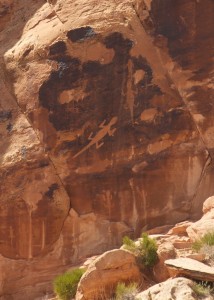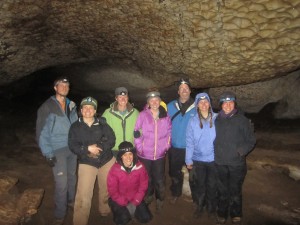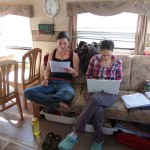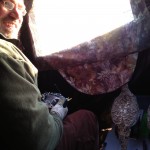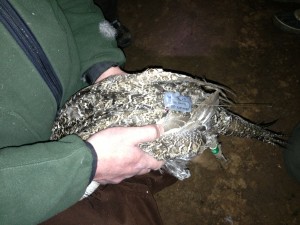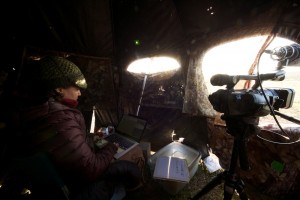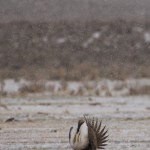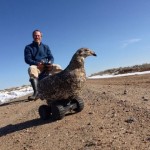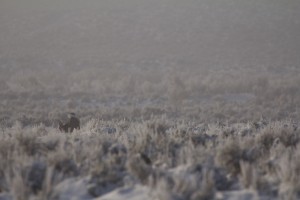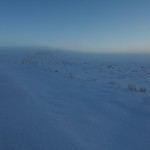One of the perks of working in Wyoming is the natural beauty all around us. This year we did a pretty good job showing the crew around- we got them to Dubois early in the season, and had fantastic weather for our Castle Gardens trip. Unfortunately we ran out of time and nice days to get up to the historical high mountain towns of South Pass City and Atlantic City, and I’m not sure any of the crew even made it up to the waterfall in Sinks Canyon.
In our last couple of weeks we did find some new adventures this year!
1- Caving in Sinks Canyon. The lower reaches of Sinks Canyon and the Popo Agie (pronounced pa poggia) are among our first stops with the crew every year. The Popo Agie crashes through it’s boulder-strewn bed and into a wide cave at the Sinks, dives underground for about a quarter of a mile, then reappears at the Rise, a calm pool filled with large trout. What happens between the Sinks and Rise has always been a matter of mystery and speculation for us, until this year! Stan was able to arrange a guided tour of a cave in an overflow channel. After dropping through a small icy grate and climbing on our hands and knees for 50 feet or so, the cave opened up into a series of long narrow chambers of scalloped rock. At a couple of places we could see water. Very cool adventure!
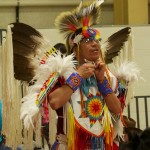 2- Riverton Pow-Wow. From the local place names to the faces we see in line at Safeway and Walmart, Native American cultures (mainly Shoshone and Arapahoe) are all around us in Lander. This year the Spring Pow-Wow coincided with our last night with the crew, so we headed to the community college in Riverton to check it out. I’ll admit to not fully understanding everything I was seeing, but I thought it was fantastic. The costumes were incredible when taken individually, and even more mesmerizing as part of an “inter-tribal”– a swirling sea of dancers shuffling around the gymnasium floor to the pounding chant of one of the drum circles. The tots in costumes were a universal favorite. Unfortunately it was rounding 9PM and the sage-grouse dances appeared to be hours off still; we’ll have to leave that for another time.
2- Riverton Pow-Wow. From the local place names to the faces we see in line at Safeway and Walmart, Native American cultures (mainly Shoshone and Arapahoe) are all around us in Lander. This year the Spring Pow-Wow coincided with our last night with the crew, so we headed to the community college in Riverton to check it out. I’ll admit to not fully understanding everything I was seeing, but I thought it was fantastic. The costumes were incredible when taken individually, and even more mesmerizing as part of an “inter-tribal”– a swirling sea of dancers shuffling around the gymnasium floor to the pounding chant of one of the drum circles. The tots in costumes were a universal favorite. Unfortunately it was rounding 9PM and the sage-grouse dances appeared to be hours off still; we’ll have to leave that for another time.
3- Flaming Gorge. As the Green River heads south of I-80, it fills a picturesque valley full of canyons, badlands, banded rock walls, and other spectacular scenery. Despite having zoomed passed this area on the interstate, this was the first trip for all three of us. On our way back to Davis, Gail, Anna and I headed down the east side of Flaming Gorge, stopping at Firehole Canyon with it’s dramatic buttes. Among the other stops were the Red Canyon overlook, which reminded me strongly of the Black Canyon of the Gunnison in Colorado (except filled with water), and the Sheep Creek Geology loop which started along a riparian area in a narrow shady canyon.
4- Dinosaur National Monument. Dinosaur N.M. lies 20 miles east of Vernal, Utah, and just south of Flaming Gorge. This is a sprawling park and we were sorry only to see one corner. The highlight of the western entrance is the Quarry exhibit. This is a stunning fossil bed containing hundreds of dinosaur bones. It was a river bed 140 million years ago, and after fossilization the stratum was tipped such that the river bed is now almost perpendicular to the ground. While about 80% of the fossils had been removed, an impressive amount were left in situ. We also had lunch by the river at Split Mountain, and went just up the road to see some neat petroglyphs.

